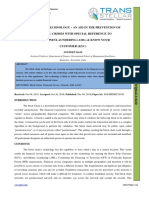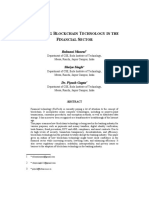0% found this document useful (0 votes)
22 views8 pagesBlockchain Assignment
The document discusses the transformative potential of blockchain technology in the banking and finance sector, highlighting its benefits such as enhanced security, improved efficiency, and reduced costs. It outlines various applications, including cross-border payments, KYC processes, capital markets, trade finance, and smart contracts, supported by case studies of successful implementations. Additionally, it addresses the challenges of scalability, regulatory uncertainty, and interoperability, while forecasting future trends like mainstream adoption and the development of Central Bank Digital Currencies.
Uploaded by
Efirem MelakuCopyright
© © All Rights Reserved
We take content rights seriously. If you suspect this is your content, claim it here.
Available Formats
Download as PDF, TXT or read online on Scribd
0% found this document useful (0 votes)
22 views8 pagesBlockchain Assignment
The document discusses the transformative potential of blockchain technology in the banking and finance sector, highlighting its benefits such as enhanced security, improved efficiency, and reduced costs. It outlines various applications, including cross-border payments, KYC processes, capital markets, trade finance, and smart contracts, supported by case studies of successful implementations. Additionally, it addresses the challenges of scalability, regulatory uncertainty, and interoperability, while forecasting future trends like mainstream adoption and the development of Central Bank Digital Currencies.
Uploaded by
Efirem MelakuCopyright
© © All Rights Reserved
We take content rights seriously. If you suspect this is your content, claim it here.
Available Formats
Download as PDF, TXT or read online on Scribd
/ 8





















































































